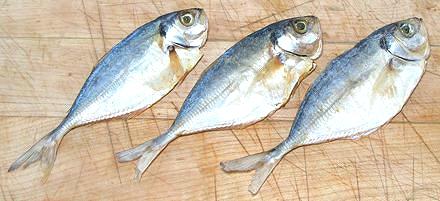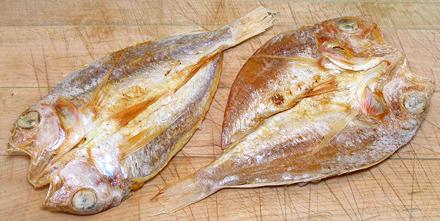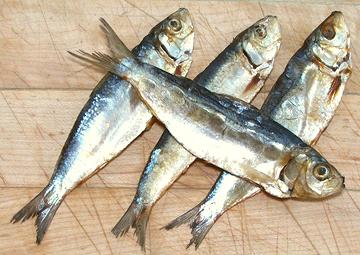
[Philippine Dried Salted Fish]
Tiny salted and dried fish are a very popular ingredient in Philippine cooking. Many different fish are treated this way and are called Daing. Dried Sardines are called Tuyo. They are used both as an ingredient and as a flavoring, particularly with rice, mung beans or other dishes that need a little flavor boost. Interestingly, though the Philippine markets here in Los Angeles are just loaded with these fish, more than a dozen varieties, none of my Philippine cookbooks even mention their existence.
The photo specimens, Salay-salay [Yellowtail Scad], were purchased from a Philippine market in Los Angeles. The fish were about 5 inches long and weighed 0.33 ounce each. For more on this fish see our Yellowtail Scad page (other scad are also used, and called Salay-salay).
More on Fish - Dried, Salted & Smoked
A Philippine lady coming to the United States was afraid daing would be hard to find here, so she packed some in her suitcase. At U.S. Customs: Customs lady, "What's this?", Filipino lady, "That's daing". Customs lady, "Honey, this here is not dying, this here is dead!"
Besides use as a snack, similarly toasted fish are often crumbled and used in rice or mung bean recipes, or any other dish that needs a bit of a flavor boost.
If the dried fish is a main recipe ingredient, usually simmered with a tomato sauce or similar, a meatier dried fish should be selected. Daing na Bisugo is an example. Because these fish are meatier, they are split and butterflied before drying.
 [Threadfin Bream; Nemipterid; Bisugo (Philippine) family
Nemipteridae]
[Threadfin Bream; Nemipterid; Bisugo (Philippine) family
Nemipteridae]
This is a very popular variety of daing, especially for recipes that
require a fish with a reasonable amount of flesh. For more on this
family of fish see our
Threadfin Bream page.
 [Gray Mullet; Banak (Philippine); Mugil cephalus]
[Gray Mullet; Banak (Philippine); Mugil cephalus]
This fish is gaining acceptance in the Philippines and farming operations
have been started. It is fleshy enough to require being butterflied for
drying. This is a worldwide fish, for more information see our
Gray Mullet page.
 [Genus Sardinella various species and Dussumieria acuta]
[Genus Sardinella various species and Dussumieria acuta]
Many kinds of small and medium herring are found in the Indo-Pacific
region, and several are popular in the Philippines, used in various ways.
The photo specimens were about 5 inches long and weighed about 0.3 ounces
each. These fish have been eviscerated in keeping with California law
(removes botulism risk) but are still labeled "To be cooked before
eating". The Philippine fish naming tends to be rather imprecise, and
"Tunsoy" covers a number of species. For more information on Herring,
see our Herring page.
 [Genus Sardinella]
[Genus Sardinella]
Many small and tiny fish are salted and dried in the Philippines and are generally called Daing, but sardines are important enough to have their own name, Tuyo. It was once considered food for the poor, since it was inexpensive, but today it is appreciated by all social classes.
While it is now used in pasta dishes and other fancy recipes, it is still a popular breakfast dish. Fried almost crisp, it is accompanied by rice, often garlic fried rice, and a spiced vinegar dip. they can also be fried up as a snack at other times of the day, but always served with a spiced vinegar dip (usually spiced with chilis).
In North America, Filipinos living in apartment buildings find
it necessary to bake the fish in the oven rather than fry it to
avoid offending non-Filipino neighbors (apartment ovens are usually
vented directly to the outside). This is done by preheating the oven
to 400°F/200°C, sealing the fish in an aluminum foil pocket,
and baking for 6 to 10 minutes.
 [Beltfish; Trichiurus lepturus]
[Beltfish; Trichiurus lepturus]
This fish can grow to 7 feet, but small ones are split, salted and
dried for use the same as other small fish under the general heading
of "daing". The photo specimen was 19-1/4 inches long and weighed
1-1/2 ounces. It was purchased from a Philippine market in Los Angeles
for 2016 US $2.99 for 3-5/8 ounces, or $13.20 / pound. For more on this
fish see our Beltfish page.